Cultural Diversity and Education
VerifiedAdded on 2020/04/07
|12
|3352
|469
AI Summary
This assignment focuses on analyzing the influence of cultural diversity on education in Australia. It requires a close examination of multiple research papers that delve into diverse aspects such as student aspirations, institutional experiences, and family migration patterns within the context of Australian education. The analysis should shed light on the multifaceted challenges and opportunities presented by cultural diversity in educational settings.
Contribute Materials
Your contribution can guide someone’s learning journey. Share your
documents today.
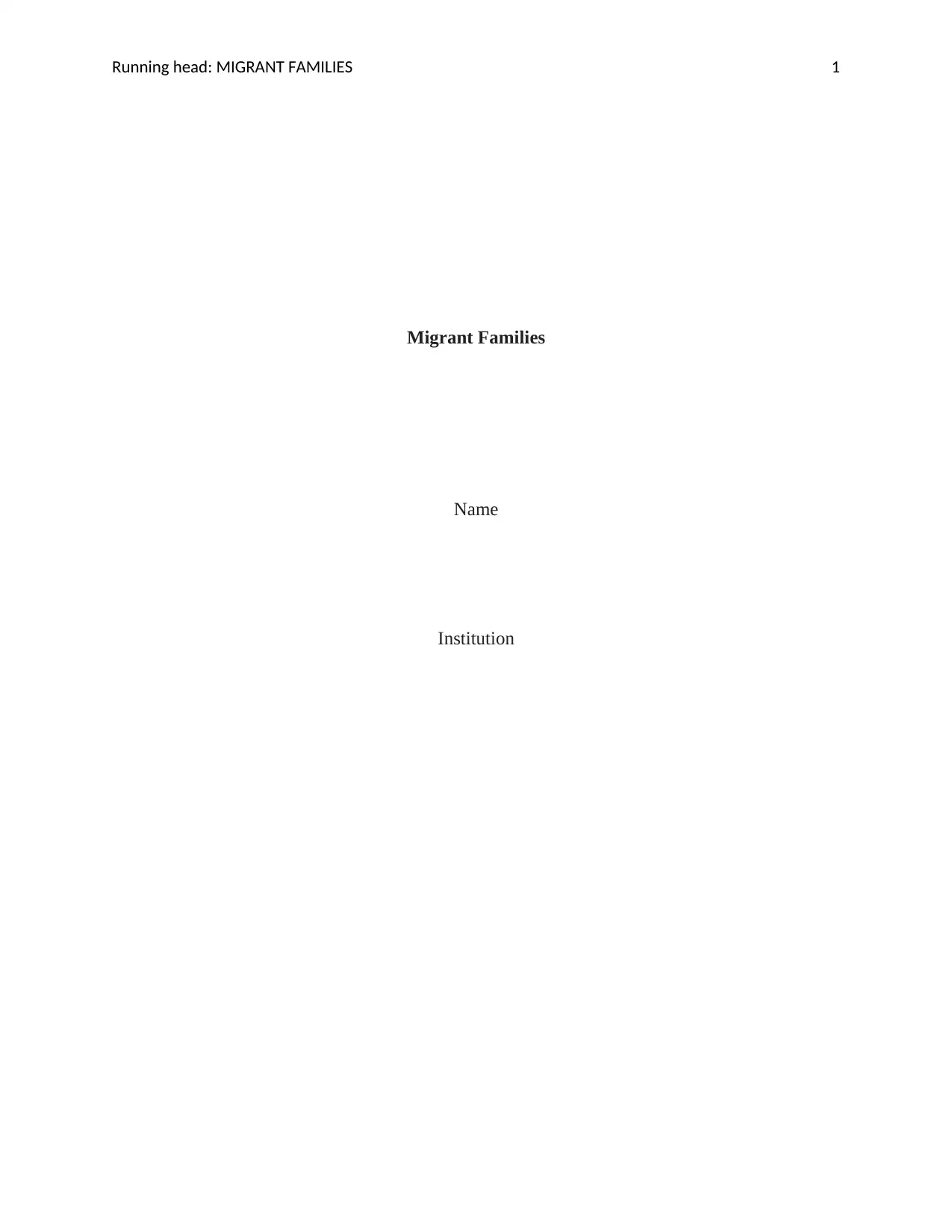
Running head: MIGRANT FAMILIES 1
Migrant Families
Name
Institution
Migrant Families
Name
Institution
Secure Best Marks with AI Grader
Need help grading? Try our AI Grader for instant feedback on your assignments.

MIGRANT FAMILIES 2
Migrant Families in Australia
Introduction
Australia is a country that is culturally and linguistically diverse. In 2011, there was a
census that was conducted which revealed that out of the total population of twenty-one million
five hundred thousand Australians, at least a quarter of the total population was born overseas
and migrated into the country at some point in their lives. An extra twenty percent of the total
population is made up of people who have either or both of their parents being immigrants.
Moreover, more than half of the entire population is made of people who are third generation
Australians (Babacan, 2014). This migration has a great effect on the families.
Of the people who migrate into Australia, some are single, couples, groups, or even
family units. A survey showed that most of the migrant families were made of couples who did
not have children. Over the years, migration of people into Australia has made the country a
multicultural country. In the beginning, the majority of migrants came from North-West Europe
and then more came in from the Eastern and Southern parts of Europe. In the last decade
however, migrants from Europe into Australia have considerably reduced. On the other hand,
there has been an influx of migrants from countries in Asia (Singh, 2016).
In Australia, cultural and linguistic diversity is expressed based on whether one
immigrated from a country that is English speaking or not. The major English speaking countries
with immigrants in Australia include; the United Kingdom, New Zealand, the United States of
America, Canada, and the Republic of Ireland (Vidal, Perales, Lersch, & Brandén, 2017).
However, people who do not come from non-main English speaking countries are not necessarily
bad at English.
Migrant Families in Australia
Introduction
Australia is a country that is culturally and linguistically diverse. In 2011, there was a
census that was conducted which revealed that out of the total population of twenty-one million
five hundred thousand Australians, at least a quarter of the total population was born overseas
and migrated into the country at some point in their lives. An extra twenty percent of the total
population is made up of people who have either or both of their parents being immigrants.
Moreover, more than half of the entire population is made of people who are third generation
Australians (Babacan, 2014). This migration has a great effect on the families.
Of the people who migrate into Australia, some are single, couples, groups, or even
family units. A survey showed that most of the migrant families were made of couples who did
not have children. Over the years, migration of people into Australia has made the country a
multicultural country. In the beginning, the majority of migrants came from North-West Europe
and then more came in from the Eastern and Southern parts of Europe. In the last decade
however, migrants from Europe into Australia have considerably reduced. On the other hand,
there has been an influx of migrants from countries in Asia (Singh, 2016).
In Australia, cultural and linguistic diversity is expressed based on whether one
immigrated from a country that is English speaking or not. The major English speaking countries
with immigrants in Australia include; the United Kingdom, New Zealand, the United States of
America, Canada, and the Republic of Ireland (Vidal, Perales, Lersch, & Brandén, 2017).
However, people who do not come from non-main English speaking countries are not necessarily
bad at English.
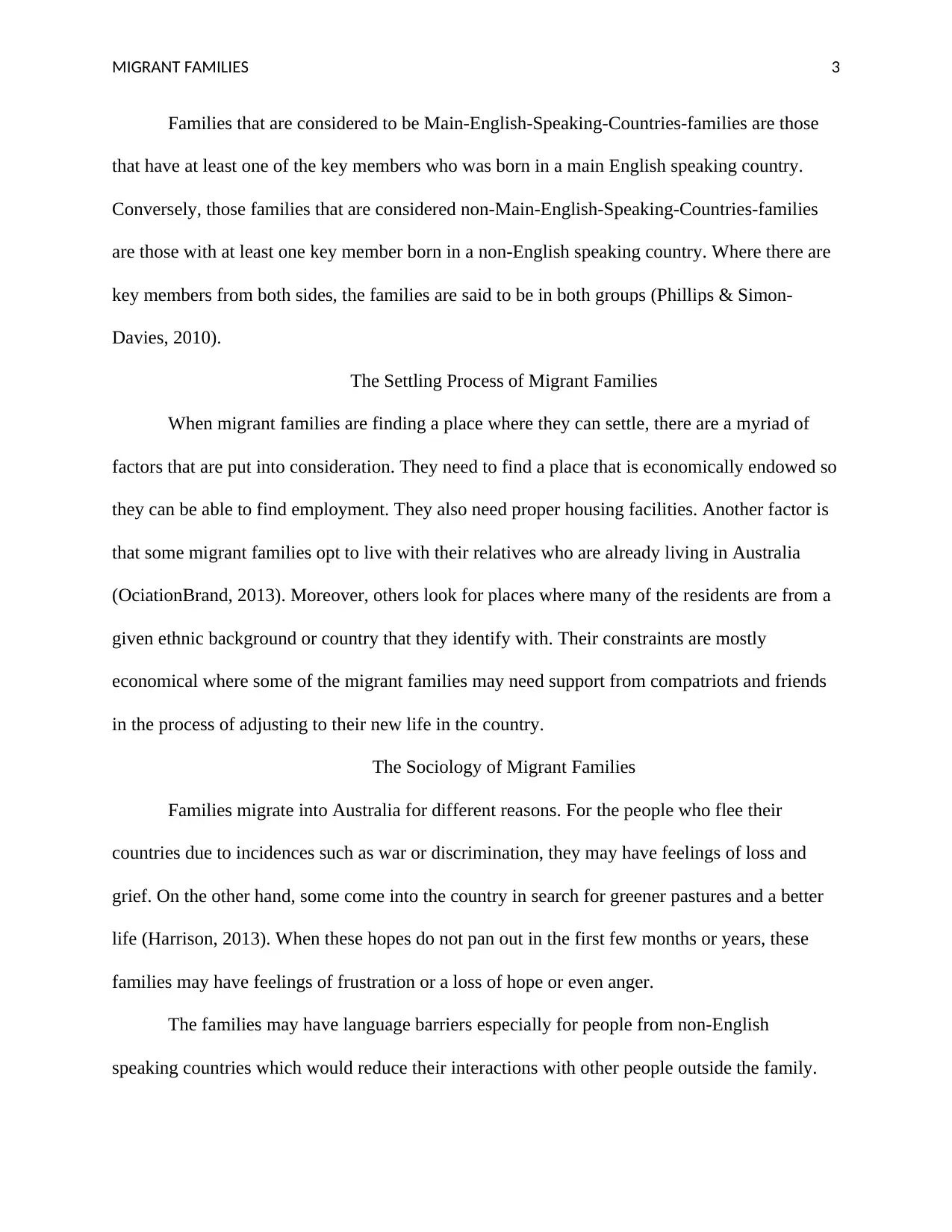
MIGRANT FAMILIES 3
Families that are considered to be Main-English-Speaking-Countries-families are those
that have at least one of the key members who was born in a main English speaking country.
Conversely, those families that are considered non-Main-English-Speaking-Countries-families
are those with at least one key member born in a non-English speaking country. Where there are
key members from both sides, the families are said to be in both groups (Phillips & Simon-
Davies, 2010).
The Settling Process of Migrant Families
When migrant families are finding a place where they can settle, there are a myriad of
factors that are put into consideration. They need to find a place that is economically endowed so
they can be able to find employment. They also need proper housing facilities. Another factor is
that some migrant families opt to live with their relatives who are already living in Australia
(OciationBrand, 2013). Moreover, others look for places where many of the residents are from a
given ethnic background or country that they identify with. Their constraints are mostly
economical where some of the migrant families may need support from compatriots and friends
in the process of adjusting to their new life in the country.
The Sociology of Migrant Families
Families migrate into Australia for different reasons. For the people who flee their
countries due to incidences such as war or discrimination, they may have feelings of loss and
grief. On the other hand, some come into the country in search for greener pastures and a better
life (Harrison, 2013). When these hopes do not pan out in the first few months or years, these
families may have feelings of frustration or a loss of hope or even anger.
The families may have language barriers especially for people from non-English
speaking countries which would reduce their interactions with other people outside the family.
Families that are considered to be Main-English-Speaking-Countries-families are those
that have at least one of the key members who was born in a main English speaking country.
Conversely, those families that are considered non-Main-English-Speaking-Countries-families
are those with at least one key member born in a non-English speaking country. Where there are
key members from both sides, the families are said to be in both groups (Phillips & Simon-
Davies, 2010).
The Settling Process of Migrant Families
When migrant families are finding a place where they can settle, there are a myriad of
factors that are put into consideration. They need to find a place that is economically endowed so
they can be able to find employment. They also need proper housing facilities. Another factor is
that some migrant families opt to live with their relatives who are already living in Australia
(OciationBrand, 2013). Moreover, others look for places where many of the residents are from a
given ethnic background or country that they identify with. Their constraints are mostly
economical where some of the migrant families may need support from compatriots and friends
in the process of adjusting to their new life in the country.
The Sociology of Migrant Families
Families migrate into Australia for different reasons. For the people who flee their
countries due to incidences such as war or discrimination, they may have feelings of loss and
grief. On the other hand, some come into the country in search for greener pastures and a better
life (Harrison, 2013). When these hopes do not pan out in the first few months or years, these
families may have feelings of frustration or a loss of hope or even anger.
The families may have language barriers especially for people from non-English
speaking countries which would reduce their interactions with other people outside the family.
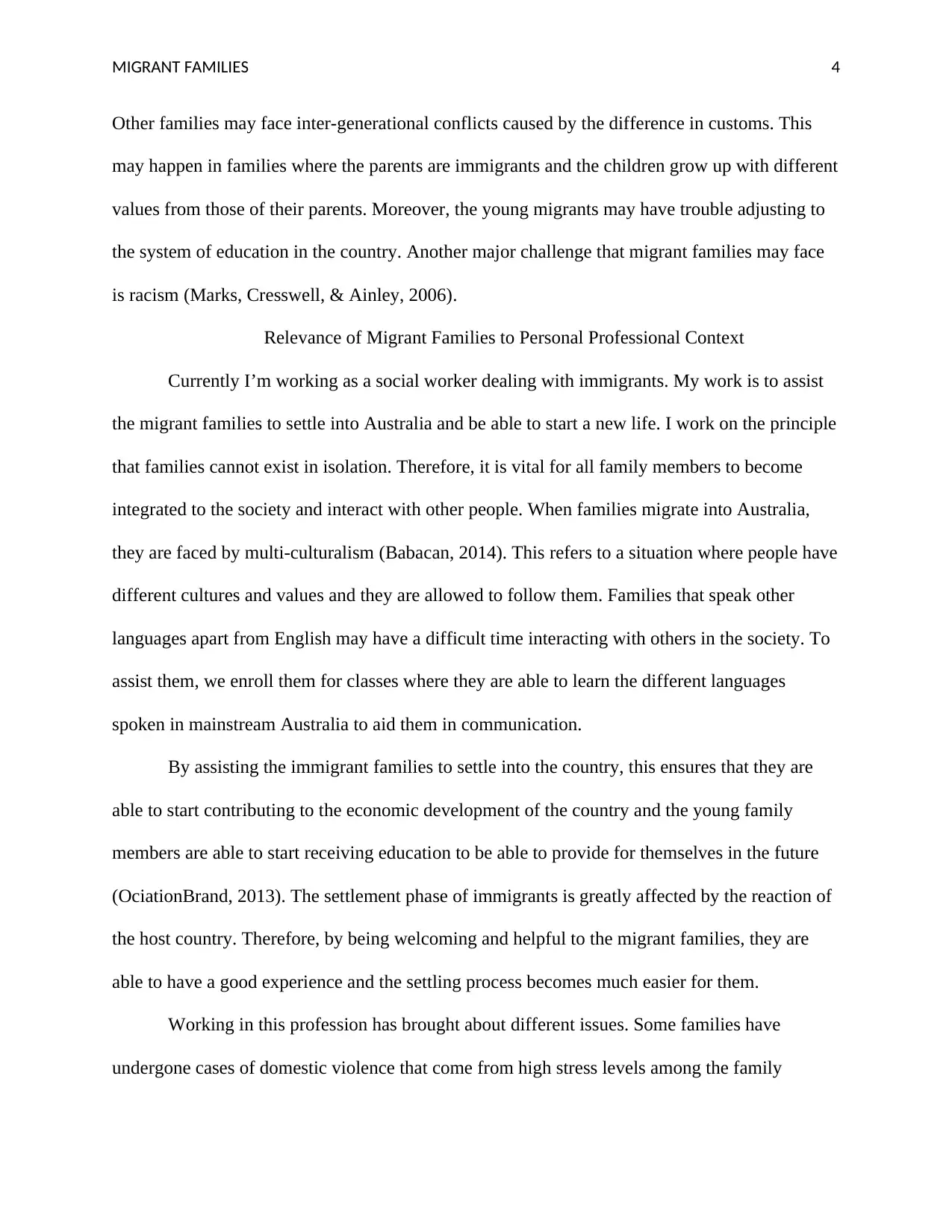
MIGRANT FAMILIES 4
Other families may face inter-generational conflicts caused by the difference in customs. This
may happen in families where the parents are immigrants and the children grow up with different
values from those of their parents. Moreover, the young migrants may have trouble adjusting to
the system of education in the country. Another major challenge that migrant families may face
is racism (Marks, Cresswell, & Ainley, 2006).
Relevance of Migrant Families to Personal Professional Context
Currently I’m working as a social worker dealing with immigrants. My work is to assist
the migrant families to settle into Australia and be able to start a new life. I work on the principle
that families cannot exist in isolation. Therefore, it is vital for all family members to become
integrated to the society and interact with other people. When families migrate into Australia,
they are faced by multi-culturalism (Babacan, 2014). This refers to a situation where people have
different cultures and values and they are allowed to follow them. Families that speak other
languages apart from English may have a difficult time interacting with others in the society. To
assist them, we enroll them for classes where they are able to learn the different languages
spoken in mainstream Australia to aid them in communication.
By assisting the immigrant families to settle into the country, this ensures that they are
able to start contributing to the economic development of the country and the young family
members are able to start receiving education to be able to provide for themselves in the future
(OciationBrand, 2013). The settlement phase of immigrants is greatly affected by the reaction of
the host country. Therefore, by being welcoming and helpful to the migrant families, they are
able to have a good experience and the settling process becomes much easier for them.
Working in this profession has brought about different issues. Some families have
undergone cases of domestic violence that come from high stress levels among the family
Other families may face inter-generational conflicts caused by the difference in customs. This
may happen in families where the parents are immigrants and the children grow up with different
values from those of their parents. Moreover, the young migrants may have trouble adjusting to
the system of education in the country. Another major challenge that migrant families may face
is racism (Marks, Cresswell, & Ainley, 2006).
Relevance of Migrant Families to Personal Professional Context
Currently I’m working as a social worker dealing with immigrants. My work is to assist
the migrant families to settle into Australia and be able to start a new life. I work on the principle
that families cannot exist in isolation. Therefore, it is vital for all family members to become
integrated to the society and interact with other people. When families migrate into Australia,
they are faced by multi-culturalism (Babacan, 2014). This refers to a situation where people have
different cultures and values and they are allowed to follow them. Families that speak other
languages apart from English may have a difficult time interacting with others in the society. To
assist them, we enroll them for classes where they are able to learn the different languages
spoken in mainstream Australia to aid them in communication.
By assisting the immigrant families to settle into the country, this ensures that they are
able to start contributing to the economic development of the country and the young family
members are able to start receiving education to be able to provide for themselves in the future
(OciationBrand, 2013). The settlement phase of immigrants is greatly affected by the reaction of
the host country. Therefore, by being welcoming and helpful to the migrant families, they are
able to have a good experience and the settling process becomes much easier for them.
Working in this profession has brought about different issues. Some families have
undergone cases of domestic violence that come from high stress levels among the family
Secure Best Marks with AI Grader
Need help grading? Try our AI Grader for instant feedback on your assignments.
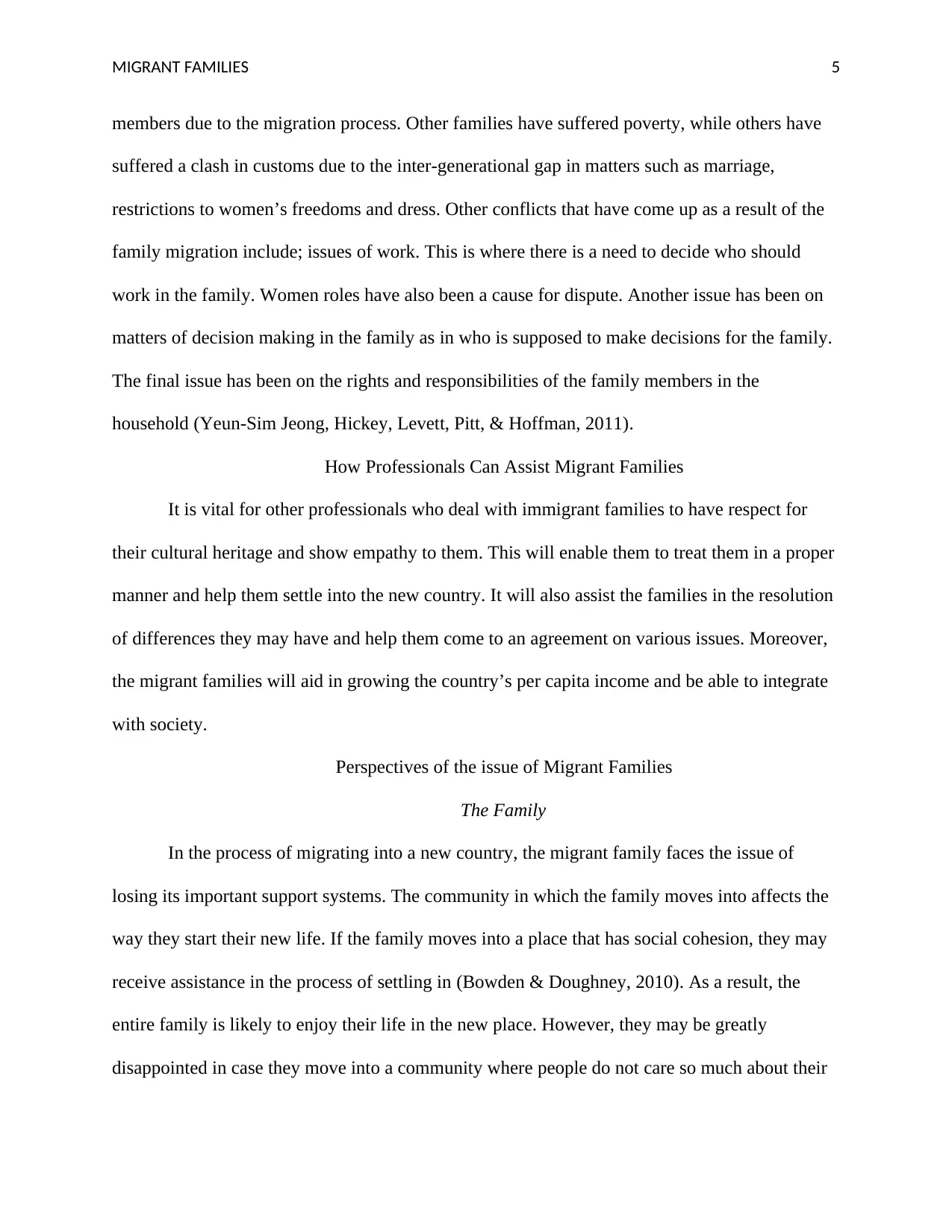
MIGRANT FAMILIES 5
members due to the migration process. Other families have suffered poverty, while others have
suffered a clash in customs due to the inter-generational gap in matters such as marriage,
restrictions to women’s freedoms and dress. Other conflicts that have come up as a result of the
family migration include; issues of work. This is where there is a need to decide who should
work in the family. Women roles have also been a cause for dispute. Another issue has been on
matters of decision making in the family as in who is supposed to make decisions for the family.
The final issue has been on the rights and responsibilities of the family members in the
household (Yeun-Sim Jeong, Hickey, Levett, Pitt, & Hoffman, 2011).
How Professionals Can Assist Migrant Families
It is vital for other professionals who deal with immigrant families to have respect for
their cultural heritage and show empathy to them. This will enable them to treat them in a proper
manner and help them settle into the new country. It will also assist the families in the resolution
of differences they may have and help them come to an agreement on various issues. Moreover,
the migrant families will aid in growing the country’s per capita income and be able to integrate
with society.
Perspectives of the issue of Migrant Families
The Family
In the process of migrating into a new country, the migrant family faces the issue of
losing its important support systems. The community in which the family moves into affects the
way they start their new life. If the family moves into a place that has social cohesion, they may
receive assistance in the process of settling in (Bowden & Doughney, 2010). As a result, the
entire family is likely to enjoy their life in the new place. However, they may be greatly
disappointed in case they move into a community where people do not care so much about their
members due to the migration process. Other families have suffered poverty, while others have
suffered a clash in customs due to the inter-generational gap in matters such as marriage,
restrictions to women’s freedoms and dress. Other conflicts that have come up as a result of the
family migration include; issues of work. This is where there is a need to decide who should
work in the family. Women roles have also been a cause for dispute. Another issue has been on
matters of decision making in the family as in who is supposed to make decisions for the family.
The final issue has been on the rights and responsibilities of the family members in the
household (Yeun-Sim Jeong, Hickey, Levett, Pitt, & Hoffman, 2011).
How Professionals Can Assist Migrant Families
It is vital for other professionals who deal with immigrant families to have respect for
their cultural heritage and show empathy to them. This will enable them to treat them in a proper
manner and help them settle into the new country. It will also assist the families in the resolution
of differences they may have and help them come to an agreement on various issues. Moreover,
the migrant families will aid in growing the country’s per capita income and be able to integrate
with society.
Perspectives of the issue of Migrant Families
The Family
In the process of migrating into a new country, the migrant family faces the issue of
losing its important support systems. The community in which the family moves into affects the
way they start their new life. If the family moves into a place that has social cohesion, they may
receive assistance in the process of settling in (Bowden & Doughney, 2010). As a result, the
entire family is likely to enjoy their life in the new place. However, they may be greatly
disappointed in case they move into a community where people do not care so much about their
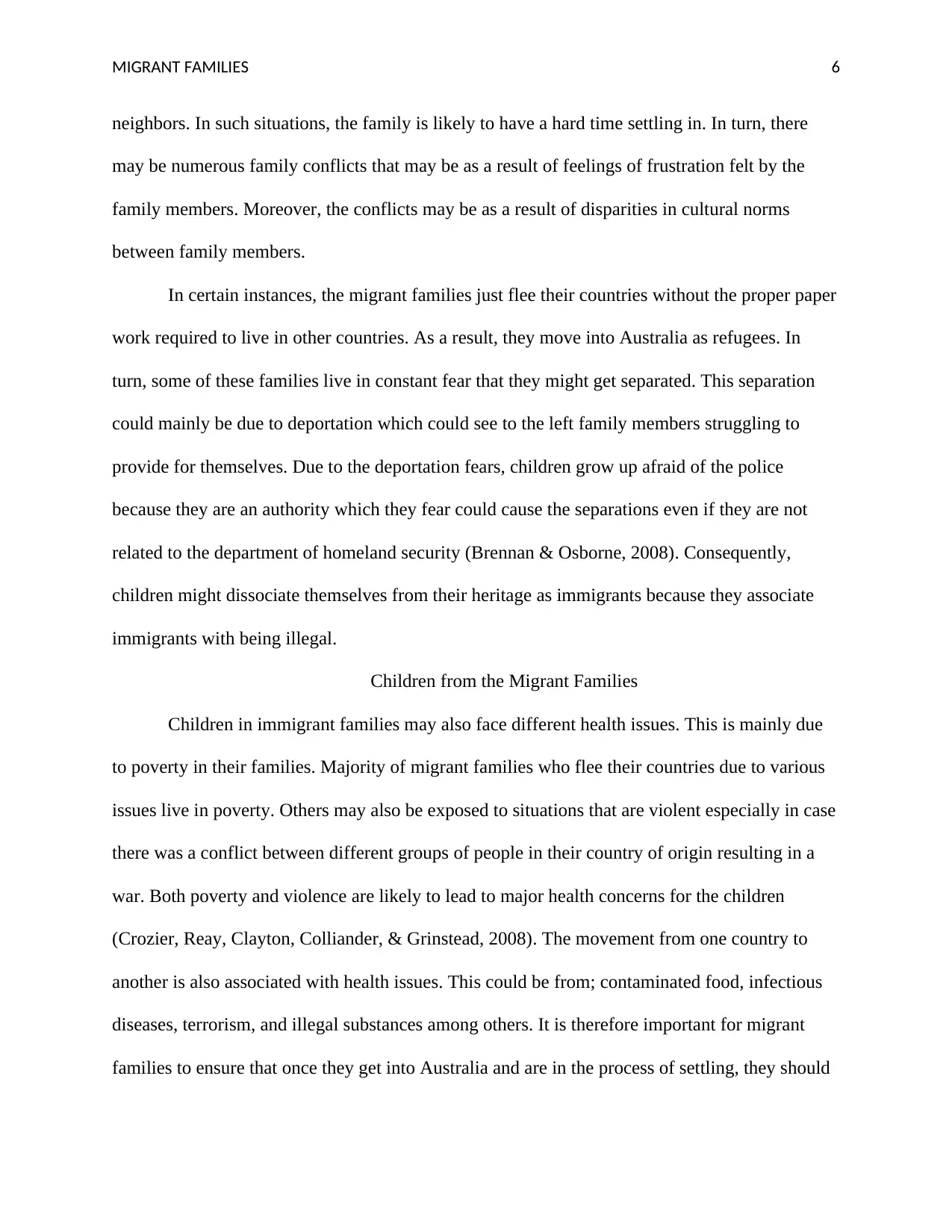
MIGRANT FAMILIES 6
neighbors. In such situations, the family is likely to have a hard time settling in. In turn, there
may be numerous family conflicts that may be as a result of feelings of frustration felt by the
family members. Moreover, the conflicts may be as a result of disparities in cultural norms
between family members.
In certain instances, the migrant families just flee their countries without the proper paper
work required to live in other countries. As a result, they move into Australia as refugees. In
turn, some of these families live in constant fear that they might get separated. This separation
could mainly be due to deportation which could see to the left family members struggling to
provide for themselves. Due to the deportation fears, children grow up afraid of the police
because they are an authority which they fear could cause the separations even if they are not
related to the department of homeland security (Brennan & Osborne, 2008). Consequently,
children might dissociate themselves from their heritage as immigrants because they associate
immigrants with being illegal.
Children from the Migrant Families
Children in immigrant families may also face different health issues. This is mainly due
to poverty in their families. Majority of migrant families who flee their countries due to various
issues live in poverty. Others may also be exposed to situations that are violent especially in case
there was a conflict between different groups of people in their country of origin resulting in a
war. Both poverty and violence are likely to lead to major health concerns for the children
(Crozier, Reay, Clayton, Colliander, & Grinstead, 2008). The movement from one country to
another is also associated with health issues. This could be from; contaminated food, infectious
diseases, terrorism, and illegal substances among others. It is therefore important for migrant
families to ensure that once they get into Australia and are in the process of settling, they should
neighbors. In such situations, the family is likely to have a hard time settling in. In turn, there
may be numerous family conflicts that may be as a result of feelings of frustration felt by the
family members. Moreover, the conflicts may be as a result of disparities in cultural norms
between family members.
In certain instances, the migrant families just flee their countries without the proper paper
work required to live in other countries. As a result, they move into Australia as refugees. In
turn, some of these families live in constant fear that they might get separated. This separation
could mainly be due to deportation which could see to the left family members struggling to
provide for themselves. Due to the deportation fears, children grow up afraid of the police
because they are an authority which they fear could cause the separations even if they are not
related to the department of homeland security (Brennan & Osborne, 2008). Consequently,
children might dissociate themselves from their heritage as immigrants because they associate
immigrants with being illegal.
Children from the Migrant Families
Children in immigrant families may also face different health issues. This is mainly due
to poverty in their families. Majority of migrant families who flee their countries due to various
issues live in poverty. Others may also be exposed to situations that are violent especially in case
there was a conflict between different groups of people in their country of origin resulting in a
war. Both poverty and violence are likely to lead to major health concerns for the children
(Crozier, Reay, Clayton, Colliander, & Grinstead, 2008). The movement from one country to
another is also associated with health issues. This could be from; contaminated food, infectious
diseases, terrorism, and illegal substances among others. It is therefore important for migrant
families to ensure that once they get into Australia and are in the process of settling, they should
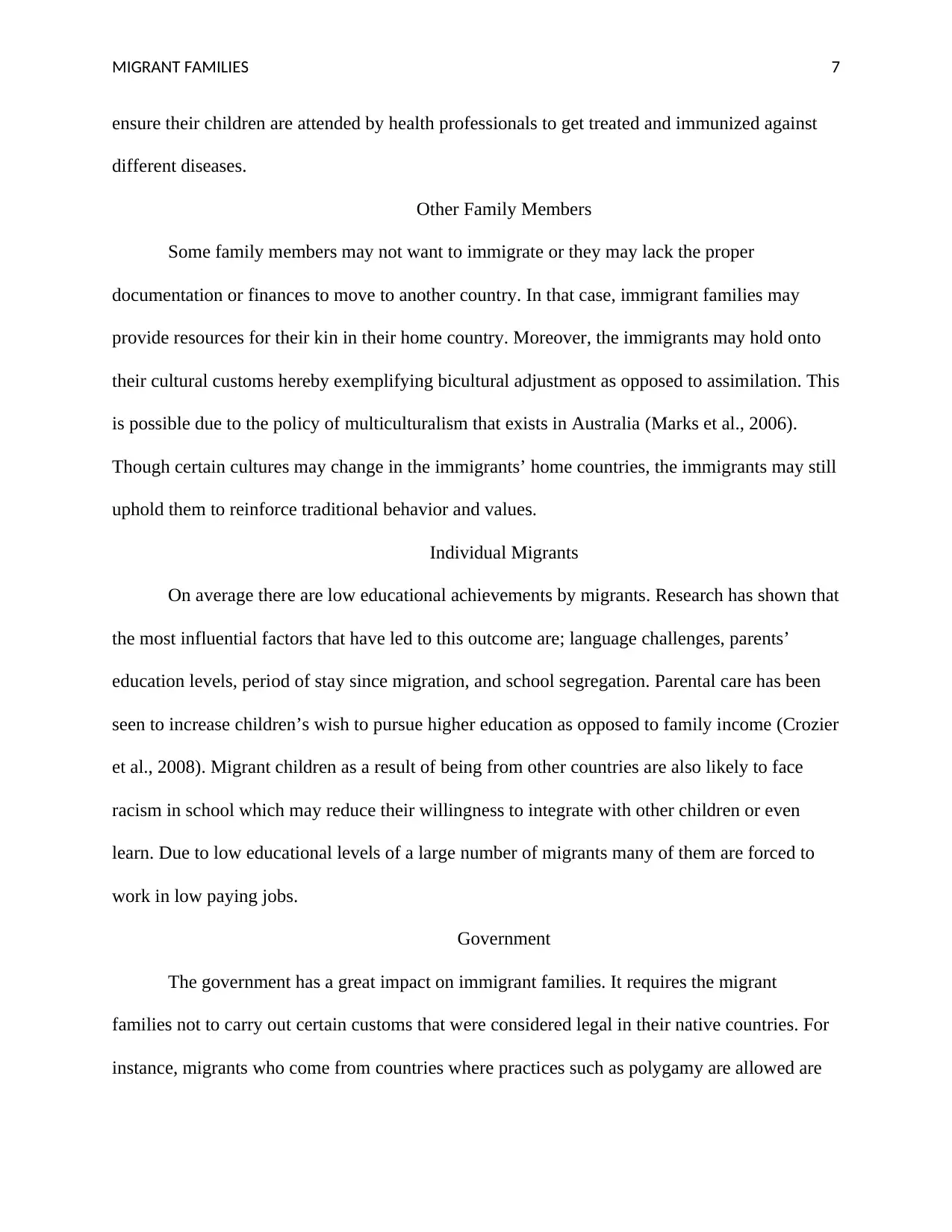
MIGRANT FAMILIES 7
ensure their children are attended by health professionals to get treated and immunized against
different diseases.
Other Family Members
Some family members may not want to immigrate or they may lack the proper
documentation or finances to move to another country. In that case, immigrant families may
provide resources for their kin in their home country. Moreover, the immigrants may hold onto
their cultural customs hereby exemplifying bicultural adjustment as opposed to assimilation. This
is possible due to the policy of multiculturalism that exists in Australia (Marks et al., 2006).
Though certain cultures may change in the immigrants’ home countries, the immigrants may still
uphold them to reinforce traditional behavior and values.
Individual Migrants
On average there are low educational achievements by migrants. Research has shown that
the most influential factors that have led to this outcome are; language challenges, parents’
education levels, period of stay since migration, and school segregation. Parental care has been
seen to increase children’s wish to pursue higher education as opposed to family income (Crozier
et al., 2008). Migrant children as a result of being from other countries are also likely to face
racism in school which may reduce their willingness to integrate with other children or even
learn. Due to low educational levels of a large number of migrants many of them are forced to
work in low paying jobs.
Government
The government has a great impact on immigrant families. It requires the migrant
families not to carry out certain customs that were considered legal in their native countries. For
instance, migrants who come from countries where practices such as polygamy are allowed are
ensure their children are attended by health professionals to get treated and immunized against
different diseases.
Other Family Members
Some family members may not want to immigrate or they may lack the proper
documentation or finances to move to another country. In that case, immigrant families may
provide resources for their kin in their home country. Moreover, the immigrants may hold onto
their cultural customs hereby exemplifying bicultural adjustment as opposed to assimilation. This
is possible due to the policy of multiculturalism that exists in Australia (Marks et al., 2006).
Though certain cultures may change in the immigrants’ home countries, the immigrants may still
uphold them to reinforce traditional behavior and values.
Individual Migrants
On average there are low educational achievements by migrants. Research has shown that
the most influential factors that have led to this outcome are; language challenges, parents’
education levels, period of stay since migration, and school segregation. Parental care has been
seen to increase children’s wish to pursue higher education as opposed to family income (Crozier
et al., 2008). Migrant children as a result of being from other countries are also likely to face
racism in school which may reduce their willingness to integrate with other children or even
learn. Due to low educational levels of a large number of migrants many of them are forced to
work in low paying jobs.
Government
The government has a great impact on immigrant families. It requires the migrant
families not to carry out certain customs that were considered legal in their native countries. For
instance, migrants who come from countries where practices such as polygamy are allowed are
Paraphrase This Document
Need a fresh take? Get an instant paraphrase of this document with our AI Paraphraser
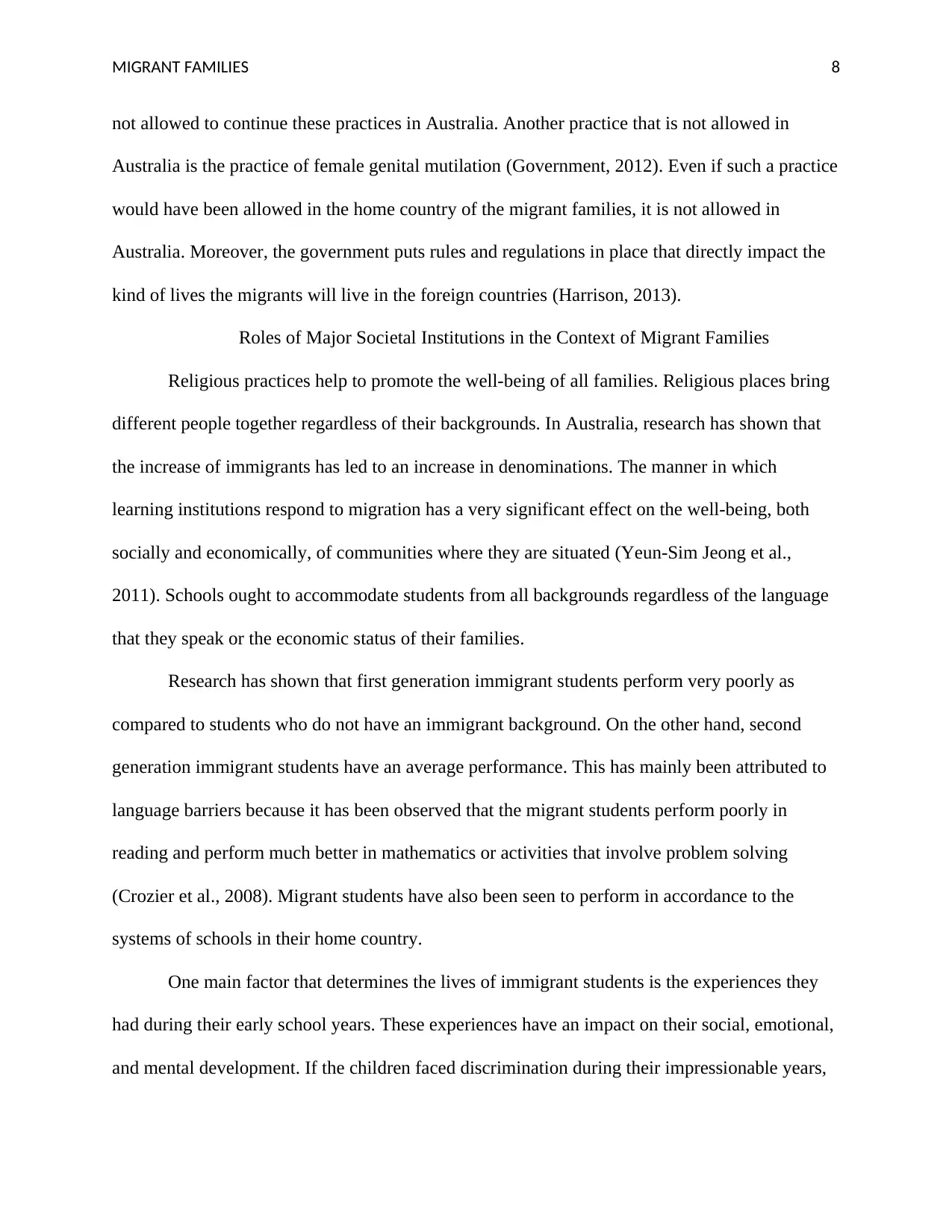
MIGRANT FAMILIES 8
not allowed to continue these practices in Australia. Another practice that is not allowed in
Australia is the practice of female genital mutilation (Government, 2012). Even if such a practice
would have been allowed in the home country of the migrant families, it is not allowed in
Australia. Moreover, the government puts rules and regulations in place that directly impact the
kind of lives the migrants will live in the foreign countries (Harrison, 2013).
Roles of Major Societal Institutions in the Context of Migrant Families
Religious practices help to promote the well-being of all families. Religious places bring
different people together regardless of their backgrounds. In Australia, research has shown that
the increase of immigrants has led to an increase in denominations. The manner in which
learning institutions respond to migration has a very significant effect on the well-being, both
socially and economically, of communities where they are situated (Yeun-Sim Jeong et al.,
2011). Schools ought to accommodate students from all backgrounds regardless of the language
that they speak or the economic status of their families.
Research has shown that first generation immigrant students perform very poorly as
compared to students who do not have an immigrant background. On the other hand, second
generation immigrant students have an average performance. This has mainly been attributed to
language barriers because it has been observed that the migrant students perform poorly in
reading and perform much better in mathematics or activities that involve problem solving
(Crozier et al., 2008). Migrant students have also been seen to perform in accordance to the
systems of schools in their home country.
One main factor that determines the lives of immigrant students is the experiences they
had during their early school years. These experiences have an impact on their social, emotional,
and mental development. If the children faced discrimination during their impressionable years,
not allowed to continue these practices in Australia. Another practice that is not allowed in
Australia is the practice of female genital mutilation (Government, 2012). Even if such a practice
would have been allowed in the home country of the migrant families, it is not allowed in
Australia. Moreover, the government puts rules and regulations in place that directly impact the
kind of lives the migrants will live in the foreign countries (Harrison, 2013).
Roles of Major Societal Institutions in the Context of Migrant Families
Religious practices help to promote the well-being of all families. Religious places bring
different people together regardless of their backgrounds. In Australia, research has shown that
the increase of immigrants has led to an increase in denominations. The manner in which
learning institutions respond to migration has a very significant effect on the well-being, both
socially and economically, of communities where they are situated (Yeun-Sim Jeong et al.,
2011). Schools ought to accommodate students from all backgrounds regardless of the language
that they speak or the economic status of their families.
Research has shown that first generation immigrant students perform very poorly as
compared to students who do not have an immigrant background. On the other hand, second
generation immigrant students have an average performance. This has mainly been attributed to
language barriers because it has been observed that the migrant students perform poorly in
reading and perform much better in mathematics or activities that involve problem solving
(Crozier et al., 2008). Migrant students have also been seen to perform in accordance to the
systems of schools in their home country.
One main factor that determines the lives of immigrant students is the experiences they
had during their early school years. These experiences have an impact on their social, emotional,
and mental development. If the children faced discrimination during their impressionable years,
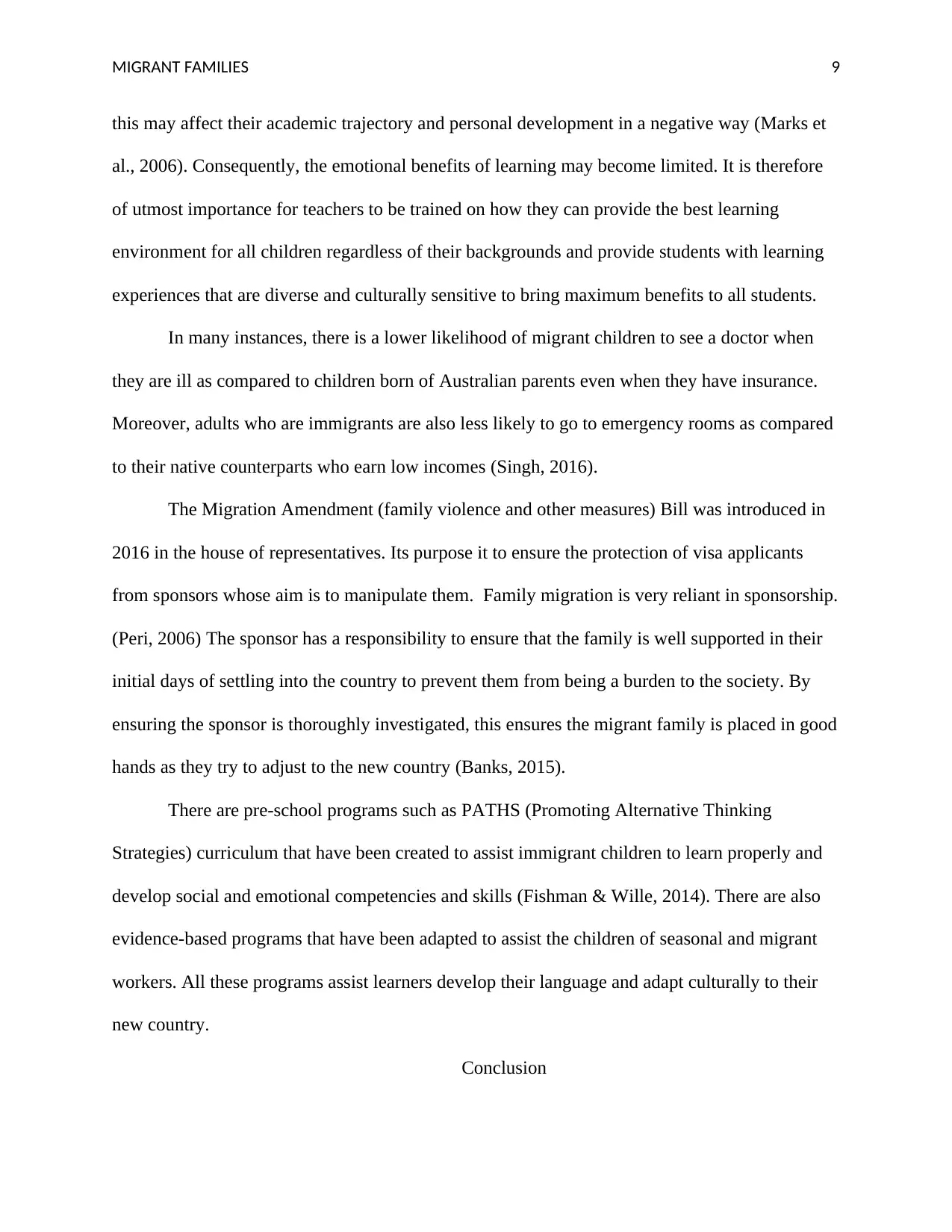
MIGRANT FAMILIES 9
this may affect their academic trajectory and personal development in a negative way (Marks et
al., 2006). Consequently, the emotional benefits of learning may become limited. It is therefore
of utmost importance for teachers to be trained on how they can provide the best learning
environment for all children regardless of their backgrounds and provide students with learning
experiences that are diverse and culturally sensitive to bring maximum benefits to all students.
In many instances, there is a lower likelihood of migrant children to see a doctor when
they are ill as compared to children born of Australian parents even when they have insurance.
Moreover, adults who are immigrants are also less likely to go to emergency rooms as compared
to their native counterparts who earn low incomes (Singh, 2016).
The Migration Amendment (family violence and other measures) Bill was introduced in
2016 in the house of representatives. Its purpose it to ensure the protection of visa applicants
from sponsors whose aim is to manipulate them. Family migration is very reliant in sponsorship.
(Peri, 2006) The sponsor has a responsibility to ensure that the family is well supported in their
initial days of settling into the country to prevent them from being a burden to the society. By
ensuring the sponsor is thoroughly investigated, this ensures the migrant family is placed in good
hands as they try to adjust to the new country (Banks, 2015).
There are pre-school programs such as PATHS (Promoting Alternative Thinking
Strategies) curriculum that have been created to assist immigrant children to learn properly and
develop social and emotional competencies and skills (Fishman & Wille, 2014). There are also
evidence-based programs that have been adapted to assist the children of seasonal and migrant
workers. All these programs assist learners develop their language and adapt culturally to their
new country.
Conclusion
this may affect their academic trajectory and personal development in a negative way (Marks et
al., 2006). Consequently, the emotional benefits of learning may become limited. It is therefore
of utmost importance for teachers to be trained on how they can provide the best learning
environment for all children regardless of their backgrounds and provide students with learning
experiences that are diverse and culturally sensitive to bring maximum benefits to all students.
In many instances, there is a lower likelihood of migrant children to see a doctor when
they are ill as compared to children born of Australian parents even when they have insurance.
Moreover, adults who are immigrants are also less likely to go to emergency rooms as compared
to their native counterparts who earn low incomes (Singh, 2016).
The Migration Amendment (family violence and other measures) Bill was introduced in
2016 in the house of representatives. Its purpose it to ensure the protection of visa applicants
from sponsors whose aim is to manipulate them. Family migration is very reliant in sponsorship.
(Peri, 2006) The sponsor has a responsibility to ensure that the family is well supported in their
initial days of settling into the country to prevent them from being a burden to the society. By
ensuring the sponsor is thoroughly investigated, this ensures the migrant family is placed in good
hands as they try to adjust to the new country (Banks, 2015).
There are pre-school programs such as PATHS (Promoting Alternative Thinking
Strategies) curriculum that have been created to assist immigrant children to learn properly and
develop social and emotional competencies and skills (Fishman & Wille, 2014). There are also
evidence-based programs that have been adapted to assist the children of seasonal and migrant
workers. All these programs assist learners develop their language and adapt culturally to their
new country.
Conclusion
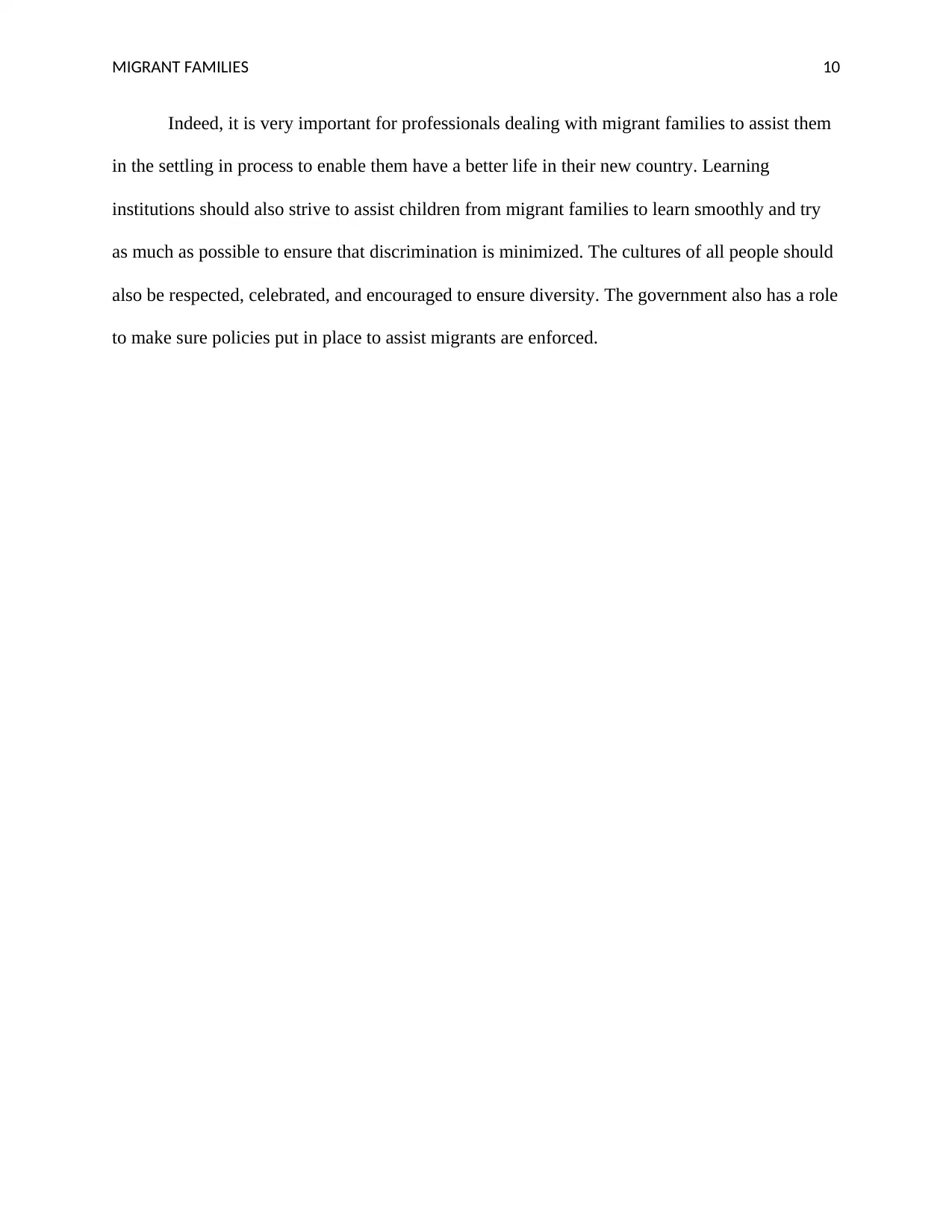
MIGRANT FAMILIES 10
Indeed, it is very important for professionals dealing with migrant families to assist them
in the settling in process to enable them have a better life in their new country. Learning
institutions should also strive to assist children from migrant families to learn smoothly and try
as much as possible to ensure that discrimination is minimized. The cultures of all people should
also be respected, celebrated, and encouraged to ensure diversity. The government also has a role
to make sure policies put in place to assist migrants are enforced.
Indeed, it is very important for professionals dealing with migrant families to assist them
in the settling in process to enable them have a better life in their new country. Learning
institutions should also strive to assist children from migrant families to learn smoothly and try
as much as possible to ensure that discrimination is minimized. The cultures of all people should
also be respected, celebrated, and encouraged to ensure diversity. The government also has a role
to make sure policies put in place to assist migrants are enforced.
Secure Best Marks with AI Grader
Need help grading? Try our AI Grader for instant feedback on your assignments.
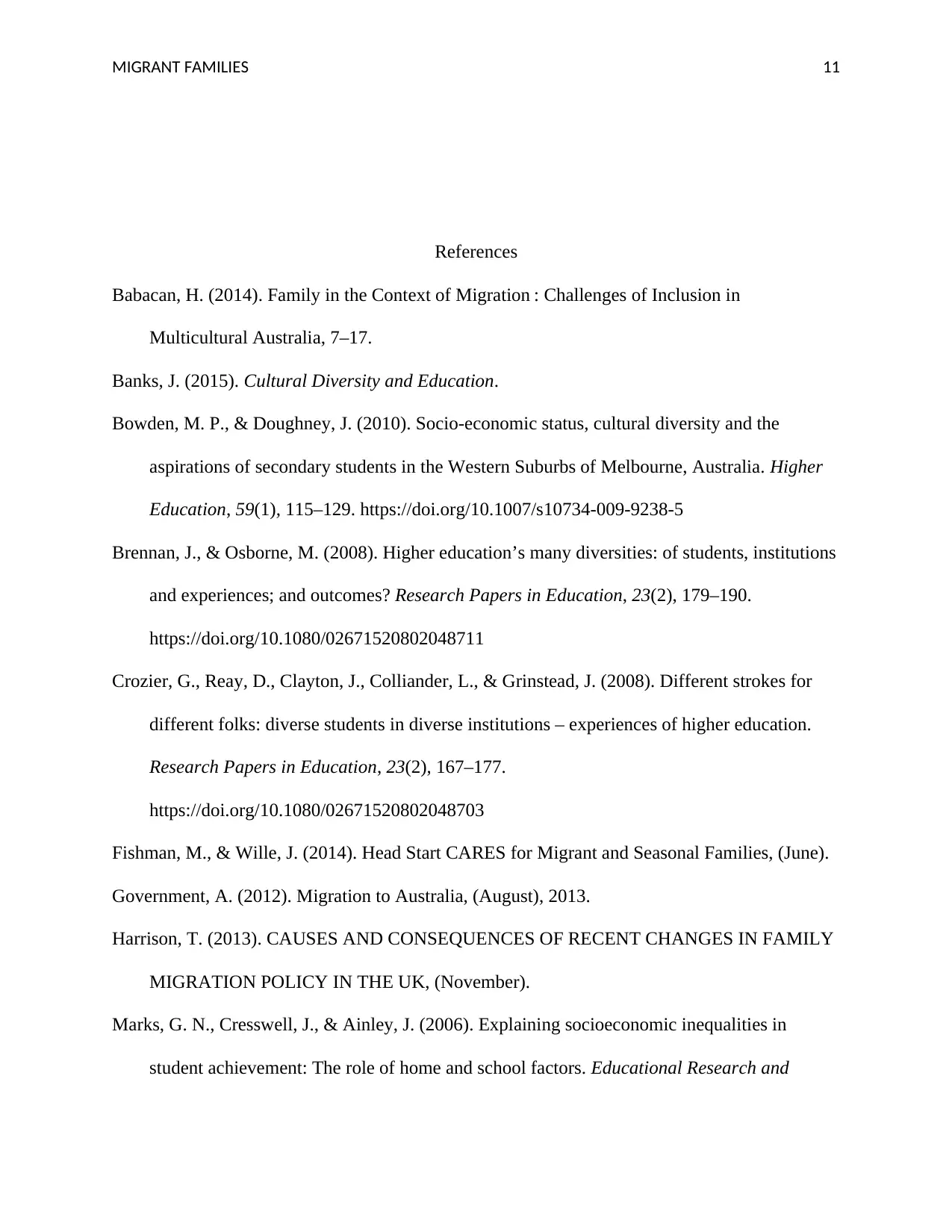
MIGRANT FAMILIES 11
References
Babacan, H. (2014). Family in the Context of Migration : Challenges of Inclusion in
Multicultural Australia, 7–17.
Banks, J. (2015). Cultural Diversity and Education.
Bowden, M. P., & Doughney, J. (2010). Socio-economic status, cultural diversity and the
aspirations of secondary students in the Western Suburbs of Melbourne, Australia. Higher
Education, 59(1), 115–129. https://doi.org/10.1007/s10734-009-9238-5
Brennan, J., & Osborne, M. (2008). Higher education’s many diversities: of students, institutions
and experiences; and outcomes? Research Papers in Education, 23(2), 179–190.
https://doi.org/10.1080/02671520802048711
Crozier, G., Reay, D., Clayton, J., Colliander, L., & Grinstead, J. (2008). Different strokes for
different folks: diverse students in diverse institutions – experiences of higher education.
Research Papers in Education, 23(2), 167–177.
https://doi.org/10.1080/02671520802048703
Fishman, M., & Wille, J. (2014). Head Start CARES for Migrant and Seasonal Families, (June).
Government, A. (2012). Migration to Australia, (August), 2013.
Harrison, T. (2013). CAUSES AND CONSEQUENCES OF RECENT CHANGES IN FAMILY
MIGRATION POLICY IN THE UK, (November).
Marks, G. N., Cresswell, J., & Ainley, J. (2006). Explaining socioeconomic inequalities in
student achievement: The role of home and school factors. Educational Research and
References
Babacan, H. (2014). Family in the Context of Migration : Challenges of Inclusion in
Multicultural Australia, 7–17.
Banks, J. (2015). Cultural Diversity and Education.
Bowden, M. P., & Doughney, J. (2010). Socio-economic status, cultural diversity and the
aspirations of secondary students in the Western Suburbs of Melbourne, Australia. Higher
Education, 59(1), 115–129. https://doi.org/10.1007/s10734-009-9238-5
Brennan, J., & Osborne, M. (2008). Higher education’s many diversities: of students, institutions
and experiences; and outcomes? Research Papers in Education, 23(2), 179–190.
https://doi.org/10.1080/02671520802048711
Crozier, G., Reay, D., Clayton, J., Colliander, L., & Grinstead, J. (2008). Different strokes for
different folks: diverse students in diverse institutions – experiences of higher education.
Research Papers in Education, 23(2), 167–177.
https://doi.org/10.1080/02671520802048703
Fishman, M., & Wille, J. (2014). Head Start CARES for Migrant and Seasonal Families, (June).
Government, A. (2012). Migration to Australia, (August), 2013.
Harrison, T. (2013). CAUSES AND CONSEQUENCES OF RECENT CHANGES IN FAMILY
MIGRATION POLICY IN THE UK, (November).
Marks, G. N., Cresswell, J., & Ainley, J. (2006). Explaining socioeconomic inequalities in
student achievement: The role of home and school factors. Educational Research and
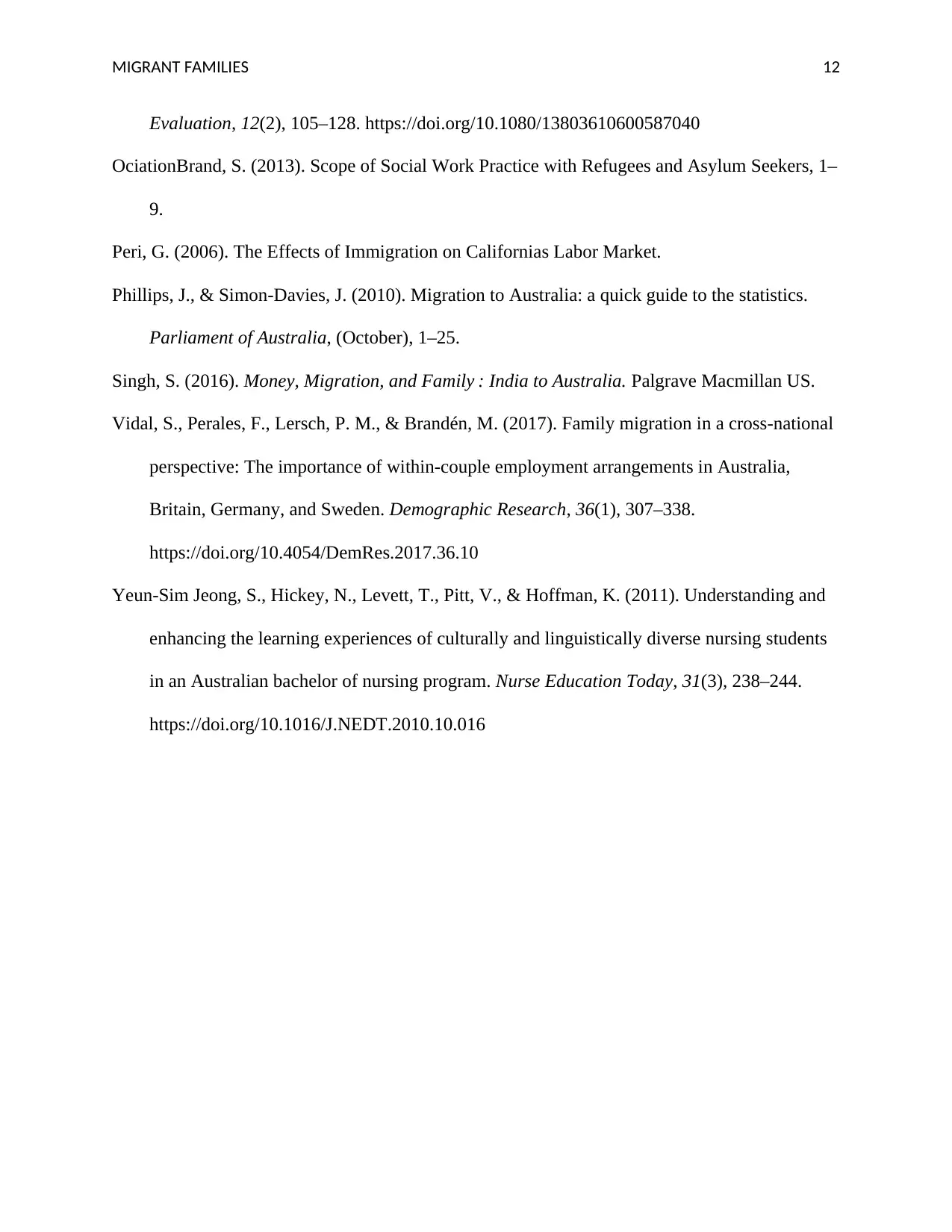
MIGRANT FAMILIES 12
Evaluation, 12(2), 105–128. https://doi.org/10.1080/13803610600587040
OciationBrand, S. (2013). Scope of Social Work Practice with Refugees and Asylum Seekers, 1–
9.
Peri, G. (2006). The Effects of Immigration on Californias Labor Market.
Phillips, J., & Simon-Davies, J. (2010). Migration to Australia: a quick guide to the statistics.
Parliament of Australia, (October), 1–25.
Singh, S. (2016). Money, Migration, and Family : India to Australia. Palgrave Macmillan US.
Vidal, S., Perales, F., Lersch, P. M., & Brandén, M. (2017). Family migration in a cross-national
perspective: The importance of within-couple employment arrangements in Australia,
Britain, Germany, and Sweden. Demographic Research, 36(1), 307–338.
https://doi.org/10.4054/DemRes.2017.36.10
Yeun-Sim Jeong, S., Hickey, N., Levett, T., Pitt, V., & Hoffman, K. (2011). Understanding and
enhancing the learning experiences of culturally and linguistically diverse nursing students
in an Australian bachelor of nursing program. Nurse Education Today, 31(3), 238–244.
https://doi.org/10.1016/J.NEDT.2010.10.016
Evaluation, 12(2), 105–128. https://doi.org/10.1080/13803610600587040
OciationBrand, S. (2013). Scope of Social Work Practice with Refugees and Asylum Seekers, 1–
9.
Peri, G. (2006). The Effects of Immigration on Californias Labor Market.
Phillips, J., & Simon-Davies, J. (2010). Migration to Australia: a quick guide to the statistics.
Parliament of Australia, (October), 1–25.
Singh, S. (2016). Money, Migration, and Family : India to Australia. Palgrave Macmillan US.
Vidal, S., Perales, F., Lersch, P. M., & Brandén, M. (2017). Family migration in a cross-national
perspective: The importance of within-couple employment arrangements in Australia,
Britain, Germany, and Sweden. Demographic Research, 36(1), 307–338.
https://doi.org/10.4054/DemRes.2017.36.10
Yeun-Sim Jeong, S., Hickey, N., Levett, T., Pitt, V., & Hoffman, K. (2011). Understanding and
enhancing the learning experiences of culturally and linguistically diverse nursing students
in an Australian bachelor of nursing program. Nurse Education Today, 31(3), 238–244.
https://doi.org/10.1016/J.NEDT.2010.10.016
1 out of 12
Related Documents
Your All-in-One AI-Powered Toolkit for Academic Success.
+13062052269
info@desklib.com
Available 24*7 on WhatsApp / Email
![[object Object]](/_next/static/media/star-bottom.7253800d.svg)
Unlock your academic potential
© 2024 | Zucol Services PVT LTD | All rights reserved.





